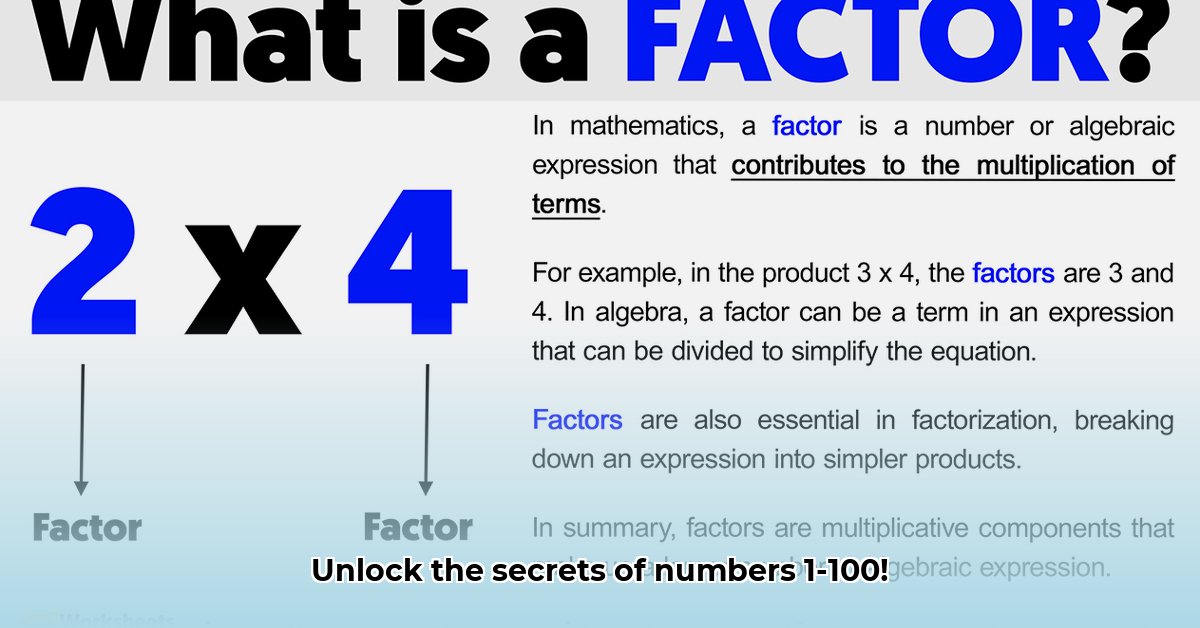Ever wondered about the hidden relationships between numbers? This guide will reveal those secrets using factor charts. We’ll demystify factors and multiples, and teach you several ways to find them – no math genius required! For further mathematical explorations, see this related resource. Discover how to build your own clear and useful factor charts, and see clever ways to represent the information. Whether you’re a student, teacher, or programmer, we’ll cover essential applications like simplifying fractions and finding the greatest common factor (GCF) and least common multiple (LCM). Plus, we’ll even peek at how factor charts are used in cryptography! Get ready to become a factor chart pro and see numbers in a whole new light.
Understanding Factors and Multiples
Let’s unravel the mystery of factor charts! These tools help us understand the inner workings of numbers. But what exactly are factors? Simply put, they’re the whole numbers that divide evenly into a given number without leaving any remainder. For instance, the factors of 12 are 1, 2, 3, 4, 6, and 12 – because each of these numbers divides perfectly into 12.
Multiples, on the other hand, are the numbers you get when you multiply a number by other whole numbers. So, multiples of 3 include 3, 6, 9, 12, and so on.
The Special Case of Number 1
Before we dive into building our factor chart, let’s clear up a common question: what about the number 1? Is it a factor? Yes, it is! The number 1 is a factor of every number. However, it’s not considered a prime number. A prime number is a number greater than 1 that has only two factors: 1 and itself. The number 1 only has one factor (itself), so it doesn’t fit the definition of a prime number.
Methods for Finding Factors
There are several approaches to finding a number’s factors.
-
The Listing Method: This is the simplest way, especially for smaller numbers. Systematically list all the numbers up to the target number and check if they divide evenly into it. For example, to find the factors of 20, you’d check 1, 2, 3, 4, and so on, noting down any numbers that leave no remainder.
-
Prime Factorization: This breaks a number down into its prime number components. Prime numbers are only divisible by 1 and themselves (examples include 2, 3, 5, 7, and so on). Prime factorization is useful for simplifying fractions, finding the greatest common factor (GCF), and the least common multiple (LCM).
-
The Factor Pair Detective: This method helps you systematically find all the factors. Imagine you’re looking for the factors of 36. You’d start searching for pairs of numbers that, when multiplied, equal 36. You’d find pairs like (1, 36), (2, 18), (3, 12), (4, 9), and (6, 6). This method ensures you don’t miss any factors!
Factor Chart: Numbers 1 to 30
This chart displays the factors and prime factorization for numbers 1 through 30. You’ll notice some interesting patterns emerge. For instance, prime numbers (like 7 or 23) only have two factors: 1 and themselves.
| Number | Factors | Prime Factorization |
|---|---|---|
| 1 | 1 | 1 |
| 2 | 1, 2 | 2 |
| 3 | 1, 3 | 3 |
| 4 | 1, 2, 4 | 22 |
| 5 | 1, 5 | 5 |
| 6 | 1, 2, 3, 6 | 2 x 3 |
| 7 | 1, 7 | 7 |
| 8 | 1, 2, 4, 8 | 23 |
| 9 | 1, 3, 9 | 32 |
| 10 | 1, 2, 5, 10 | 2 x 5 |
| 11 | 1, 11 | 11 |
| 12 | 1, 2, 3, 4, 6, 12 | 22 x 3 |
| 13 | 1, 13 | 13 |
| 14 | 1, 2, 7, 14 | 2 x 7 |
| 15 | 1, 3, 5, 15 | 3 x 5 |
| 16 | 1, 2, 4, 8, 16 | 24 |
| 17 | 1, 17 | 17 |
| 18 | 1, 2, 3, 6, 9, 18 | 2 x 32 |
| 19 | 1, 19 | 19 |
| 20 | 1, 2, 4, 5, 10, 20 | 22 x 5 |
| 21 | 1, 3, 7, 21 | 3 x 7 |
| 22 | 1, 2, 11, 22 | 2 x 11 |
| 23 | 1, 23 | 23 |
| 24 | 1, 2, 3, 4, 6, 8, 12, 24 | 23 x 3 |
| 25 | 1, 5, 25 | 52 |
| 26 | 1, 2, 13, 26 | 2 x 13 |
| 27 | 1, 3, 9, 27 | 33 |
| 28 | 1, 2, 4, 7, 14, 28 | 22 x 7 |
| 29 | 1, 29 | 29 |
| 30 | 1, 2, 3, 5, 6, 10, 15, 30 | 2 x 3 x 5 |
Choosing the Right Representation
Different visual tools help illustrate the same idea in different ways.
| Method | Advantages | Disadvantages |
|---|---|---|
| List of Factors | Simple, easy to understand for smaller numbers. | Can get unwieldy and less clear for larger numbers. |
| Factor Chart | Organized, clear, visually appealing, and efficient. | Can seem overwhelming for very large ranges of numbers. |
| Prime Factorization Tree | Clearly shows the steps of breaking down a number into primes. | Can be complex to draw and interpret for large numbers. |
Applications of Factor Charts
Factor charts are valuable tools with surprising applications:
- Simplifying Fractions: Finding the GCF (greatest common factor) using a factor chart helps reduce fractions to their simplest form.
- Finding the GCF and LCM: These are fundamental operations in algebra, and factor charts provide a direct path to finding them efficiently.
- Cryptography: Prime factorization plays a role in encryption techniques. RSA encryption, for example, relies on the fact that it’s easy to multiply two large prime numbers together, but very difficult to factor the result back into the original primes.
Mastering factor charts empowers you to understand numbers on a deeper level. It’s a skill that opens doors to more complex mathematical concepts.
Beyond the Basics
Key Takeaways:
- Understanding prime factorization is useful for various applications.
- Several algorithms exist for finding prime factors, each with strengths and weaknesses.
- The choice of algorithm depends on the size of the number and computational resources.
More on Prime Numbers
A factor of a number divides it evenly, leaving no remainder. A multiple of a number is the result of multiplying that number by an integer. For example, the factors of 12 are 1, 2, 3, 4, 6, and 12. The multiples of 12 are 12, 24, 36, and so on. As mentioned earlier
- Bulking Lunch Recipes that Make Muscle Gain Delicious - November 12, 2025
- Simple Asian Meal Prep Recipes to Spice Up Your Week - November 11, 2025
- Simple Asian Meal Prep Ideas For Healthy And Flavorful Weekday Meals - November 10, 2025










